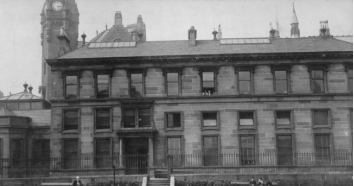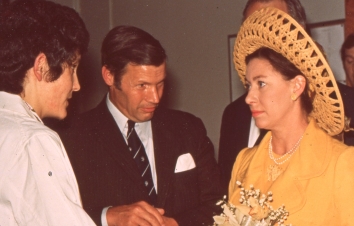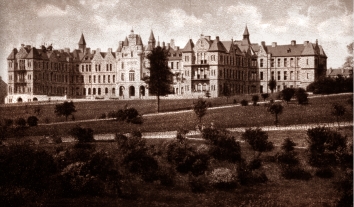Medicine
The University of Glasgow established Chairs and Departments of Medicine at both Glasgow Royal Infirmary and the Western Infirmary, Glasgow. Each of these large hospitals contributed significantly to the education of medical and nursing students, in addition to providing good medical care to the ever growing and ageing population of Glasgow. Dental students were also taught Medicine at the Royal Infirmary.
The Regius Chair of the Practice of Medicine was established in 1637, lapsed in 1646, and was revived in 1713 by Queen Anne. The opening of the Western Infirmary in 1874 meant that it became the new teaching hospital for Glasgow. Its situation next to the main University Campus at Gilmorehill was of prime importance. Many university medical staff, including Regius Professors, therefore moved to the new Western Infirmary from the Royal Infirmary.
Royal Infirmary

Having had to transfer the Regius Chairs to the Western Infirmary in 1874, the Royal Infirmary sought to redeem the situation.
- First, in 1876, it pioneered its own College of Medicine, housed in what was then the new St Mungo’s College building. By 1948, this Medical College no longer existed, and the building belonged to the University of Glasgow.
- Second, the Muirhead Chair of Medicine was set up in 1911, through an endowment from the Trustees of Henry Muirhead (1814-1890). The ‘new’ Department of Medicine was housed after 1948 in the St Mungo College Building.
In 1983, the Department of Medicine moved to the new University Block at the Royal Infirmary together with the University Departments of Medical and Surgical Cardiology, Surgery, and Obstetrics and Gynaecology along with the NHS Department of Vascular Surgery and a combined University and NHS Department of Medical Illustration. The building included a large new library, lecture theatres, teaching laboratories and dining room for staff and students. Although the building was first opened in 1983, it was formally opened by the Queen in 1986.

Around 2011, the building was closed for a few years for a complete refurbishment with levels 2-5 being totally reconfigured. The NHS occupied levels 4 and 5 while the University retrenched to levels 2 and 3. The University block was then named the New Lister Building.
A fascinating discovery was the uncovering of several skeletons..
A fascinating discovery was the uncovering of several skeletons, buried just below the surface, during excavations to build a link corridor from the surgical block in the old part of the Royal Infirmary to the new Hospital. Pathological examination deemed these to be the remains of patients who had died during one of the cholera epidemics in the 1840s. They were duly reinterred elsewhere. In 2001, the St Mungo’s College building was deemed unsafe and was largely demolished.
Muirhead Professors of Medicine from 1948
- Leslie John Davis (1899-1980) was Muirhead Professor of Medicine (1945-1961). He was appointed to develop scientific medicine in the University Department of Medicine at Glasgow Royal Infirmary. His major interest was in Haematology, including Haemostasis and Thrombosis, developed by A Stuart Douglas who had a personal professorship (1964). For a personal story of Davis and his Department from 1952-1955 by Dr Stuart McAlpine, his senior house officer, to see an interview visit RCPSG.
- Edward McCombie McGirr (1916-2003) was Muirhead Professor of Medicine (1961-1978); President of the Royal College of Physicians and Surgeons of Glasgow (1970-1971); and Dean of the Faculty of Medicine (1974-1981). He was appointed CBE in 1978; and was appointed Dean of Faculties and awarded an Honorary DSc by the University in 1994. His research interests were in Endocrinology and Nuclear Medicine, in which fields he studied enzyme defects underlying dishormonogenetic goitres, leading to an MD with Honours and the Bellahouston Medal. He expanded the Department’s specialty interests into Renal Medicine initially with the assistance of Dr Arthur C Kennedy who had a personal professorship; and Rheumatology initially with the assistance of Dr Watson Buchanan who had a personal professorship (1972). Dr Ann Glen researched in gastroenterology before moving to the University of Edinburgh Find out more). Dr Thomas (Tam) McEwen was the NHS consultant on the unit for many years, and visiting consultant physician to Canniesburn Hospital. As Dean, McGirr founded Nursing Studies in the University. For a personal story of McGirr and his Department in the 1960s by Dr Harry Gray, junior doctor, read more.

- Arthur Colville Kennedy (1922-2009) was Muirhead Professor of Medicine (1979-1988). His main interest from 1958 was Renal Medicine and renal dialysis, following acquisition of a rotating-drum artificial kidney machine in 1960. He was awarded a personal chair in 1969; and was President of the Royal College of Physicians and Surgeons of Glasgow (1986-1988).
- James Hugh McKillop was Muirhead Professor of Medicine (1989-2011). His research interests were in Endocrinology and Nuclear Medicine. He also served as Head of the Undergraduate Medical School and Deputy Executive Dean of Medicine. As a member of the UK General Medical Council, he chaired its Undergraduate Board (2009-2012) and chaired the review which produced the 2013 edition of Good Medical Practice. He was awarded honorary doctorates by Orebro University (Sweden) and International Medical University (Malaysia). He developed the Department’s specialty interests in Rheumatology (Roger Sturrock became the first Macleod/ARC Professor of Rheumatology), Cardiovascular Disease (Gordon Lowe had a personal professorship in Vascular Medicine, 1995); Geriatric Medicine (David Stott became Cargill Professor in 1994, the chair moving from the Southern General Hospital); Stroke (Peter Langhorne had a personal professorship in Stroke Care, 2000); and Haematology (Ian Franklin became Professor of Transfusion Medicine, 1996, jointly with the Scottish Blood Transfusion Service; Tessa Holyoake had a personal professorship in Experimental Haematology, 2004) but she sadly died in 2017.
The current Muirhead Professor of Medicine is Iain McInnes who was Professor of Experimental Medicine and Rheumatology, and was Director of the School of Infection and Immunology. He is Vice principal and Head of the College of medical and Life Sciences. The Royal Infirmary continues to teach Medicine to students, both on its medical wards, and in teaching suites in its refurbished New Lister Building (opened 2014).
Western Infirmary

In 1874, when the new Western Infirmary opened, the Regius Chair of the Practice of Medicine transferred to this teaching Hospital.
After 1938, it was housed in the Gardiner Institute at the Western Infirmary site. Its name changed to Medicine and Therapeutics in 1989, when it incorporated the Department of Materia Medica from Stobhill Hospital.
The Western Infirmary closed in 2016, and its beds transferred to the new Queen Elizabeth University Hospital on the Southern General Hospital site.
Regius Professors of Medicine from 1948
- Sir John William McNee (1887-1984) was Regius Professor of Practice of Medicine at the Western Infirmary (1936-1953), and was awarded an LLD in 1954. He had performed pioneering research on the liver and spleen, and co-authored a Textbook of Medical Treatment (1939). It was at his request that the Gardiner Institute was funded by a local ship owner.
He set up:- ‘magnificent offices, consulting rooms, six research beds with their own diet kitchen, and very ample laboratory space'. He was Physician to the King in Scotland (1937-1952) and to the Queen (1952-1954). He was knighted in 1951.
- Sir Edward Johnson Wayne (1902-1990) was Regius Professor of Practice of Medicine at the Western Infirmary (1953-1967). He researched into thyroid disease, cardiovascular disease, osteoporosis and blood disorders. Before the development of laboratory thyroid function tests he championed the use of ‘Wayne’s Index’ for the better diagnosis of thyroid disease. Medical students in his wards never forgot the cardinal signs of thyroid dysfunction. He was Chairman of the Clinical Research Board of the UK Medical Research Council (1960-1964) and Honorary Physician to the Queen in Scotland (1954-1957). His work on the British Medical Association’s Committee on Alcohol and Road Accidents led to the introduction of the blood alcohol limit of 80 mg/ml in the UK Road Safety Act, 1967. He was knighted in 1964.
- Graham Malcolm Wilson (1917-1977) was Regius Professor (1967-1977). His primary interests were the peripheral circulation and endocrinology (especially thyroid disease and bone metabolism), as well as renal and metabolic disorders. He was deeply involved in the planning of medical education. He was Chairman of the Medicines Committee in 1976.
- Sir Abraham Goldberg (1923-2007) was Regius Professor of Materia Medica at Stobhill Hospital (1970-1978) and Regius Professor of Practice of Medicine at the Western Infirmary (1978-1989). He was awarded a DSc by the University in 1966. He was a renowned teacher and clinical scientist who specialised in haematology and was recognised as a leading authority on the genetic disease porphyria (see Haematology). He also researched (with Dr Michael Moore) the effects of lead (from water pipes) in the Glasgow drinking water on child development. He chaired the UK Committee on Safety of Medicines for six years, and in 1973 chaired the UK Medical Research Council’s clinical research board. In 1983 he was knighted for his services to Medicine, and in 1989 he was honoured with the City of Glasgow Lord Provost’s award for public service (find out more).
- John Reid was Regius Professor of Materia Medica (1978-1989) at Stobhill Hospital and then Regius Professor of Medicine and Therapeutics at the Western Infirmary (1989-2010). His principal research interest was high blood pressure (hypertension), including studies in the Glasgow Blood Pressure Clinic; with the MRC Blood Pressure Unit at the Western Infirmary; with Professors John Connell (Professor of Endocrinology 1995), Anna Dominiczak (Professor of Cardiovascular Medicine 1997) and Gordon McInnes (Professor of Clinical Pharmacology 2003); and with Drs Peter Semple, Peter Rubin, Peter Meredith and others (see Cardiovascular Disease).
Dame Anna Dominiczak was appointed Regius Professor of Medicine and Therapeutics in 2009, the first woman to hold any of the University’s Regius Chairs. She previously held a British Heart Foundation Chair of Cardiovascular Medicine at the University (1997-2010) as well as Directorship of the Cardiovascular Research Centre (2006-2010). In 2010 she became Vice-Principal and Head of the newly formed College of Medical, Veterinary and Life Sciences. For her services to cardiovascular and medical sciences she was appointed Dame Commander of the Order of the British Empire in 2016.
Other Staff Members
Other members of the Department included
- Professor Brian Whiting, Professor of Materia Medica (1986-2001), who researched in population pharmacodynamics and pharmacokinetics, and development of expert systems in therapeutics. He was Dean of the Faculty of Medicine and Head of the Clinical Medicine Planning Unit (1992-2000).
- Professor Stewart Hillis (Professor of Cardiovascular and Exercise Medicine 1997) pioneered coronary thrombolysis treatment, and developed Sports Medicine (see Cardiovascular Disease). Professor Martin Brodie (Professor of Medicine and Clinical Pharmacology, 1995) established an epilepsy unit in 1982 (see Neurology).
- Professor Kenneth McColl (Professor of Gastroenterology 1995) researched in Gastroenterology.
- Professor Kennedy Lees (Professor of Cerebrovascular Medicine 1999) established an Acute Stroke Unit (see Stroke).
- Dr Alastair McLellan (honorary Professor) developed the Bone Metabolism Clinic (see Endocrinology); and is currently Dean of Postgraduate Medicine (West of Scotland Region) and Director of NHS Education Scotland.
Lectures in Medicine
The Departments of Medicine at the Royal Infirmary and the Western Infirmary had traditionally arranged separate systematic lecture courses in Medicine for medical undergraduates. During the 1980s, the two departments jointly developed a single course of lectures accompanied by a large new lecture theatre opening near the Western Infirmary. Following the publication of Tomorrow's Doctors in 1993, a new medical curriculum was introduced in 1996.
This resulted in a radical reduction of traditional lectures and their replacement by small group learning, including problem based learning, following the experiences of McMaster University in Canada and Maastricht University in the Netherlands. Professor McKillop moved to head the new Undergraduate Medical School on University Avenue, assisted by Drs Marjorie Allison and Max Field from the Department of Medicine at the Royal Infirmary, and Professor Jill Morrison from the Department of General Practice.
Professor Gordon Lowe and Dr Marjorie Allison

